Dom intro
Download as PPT, PDF1 like403 views
Machine design is the process of creating and improving machines. It involves selecting appropriate materials based on their physical and mechanical properties, and designing machine parts to withstand forces without failing while minimizing production costs. Key considerations include avoiding stress concentrations from abrupt changes in geometry, providing generous radii to reduce stresses, and not locating weakening features like holes in highly stressed areas.
1 of 26
Downloaded 21 times
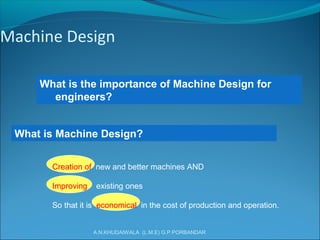
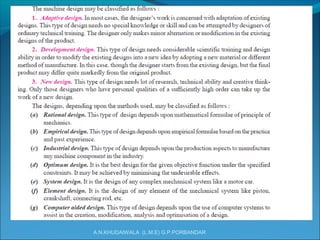
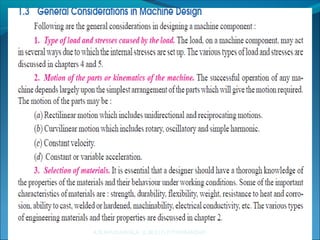
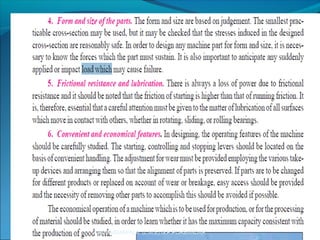
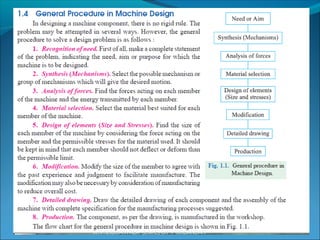
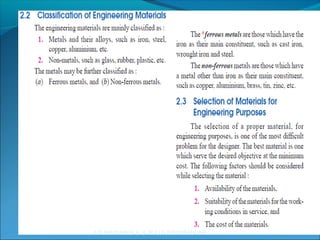
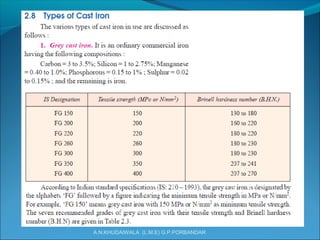
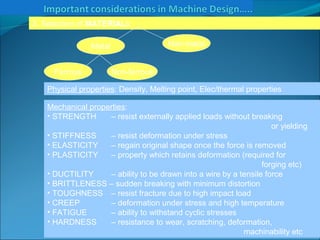
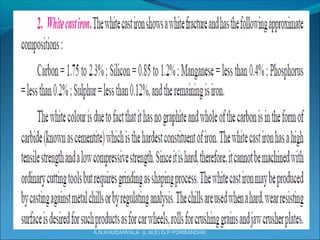
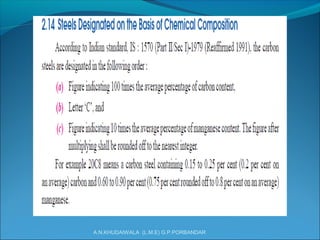
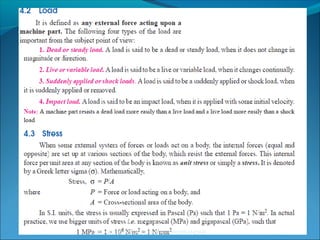
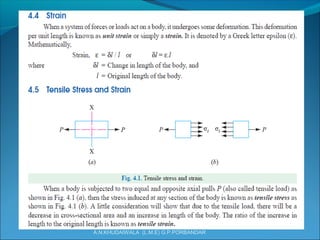
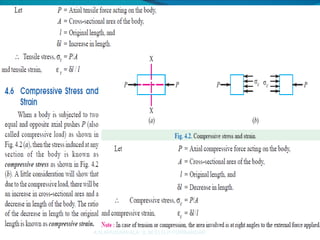

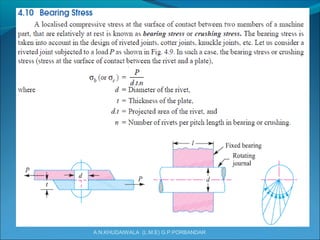
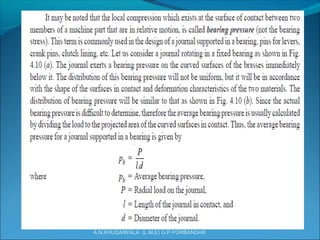

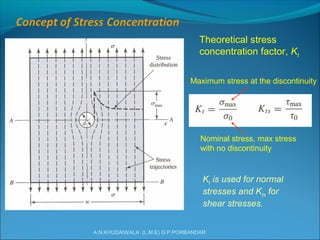
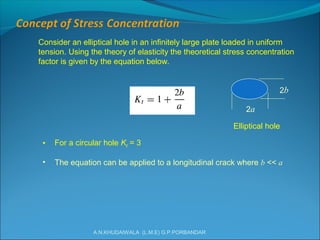
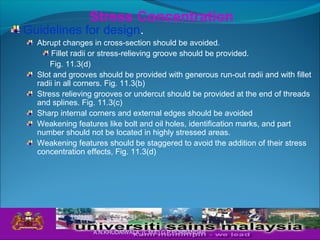
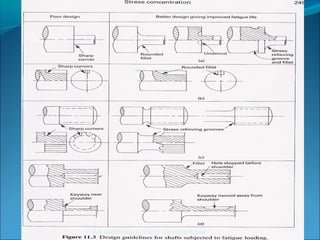
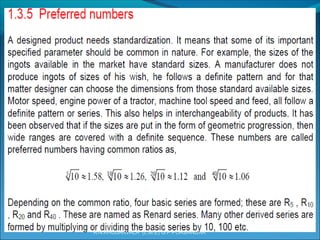
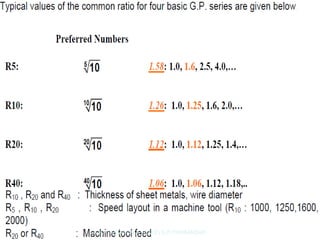
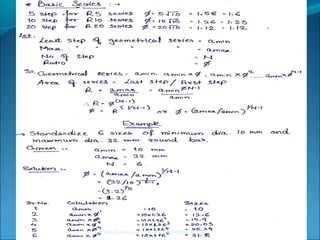
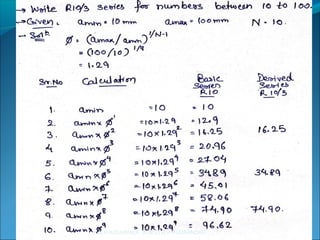

Recommended
Mihir 19 sept_water on graphene



Mihir 19 sept_water on grapheneMIHIR RANJAN SAHOO
Ėý
This document summarizes a study of water adsorption on graphene using first principles calculations. The author finds that water adsorbs weakly on graphene with adsorption energies between 28-54 meV depending on orientation. While the band structure of graphene remains largely unchanged, there is a small charge transfer between water and graphene that depends on the orientation of the water molecule. Specifically, an up orientation leads to water donating charge as a donor, while down and pointing orientations result in water accepting charge from graphene as an acceptor. The experimentally observed behavior of water acting as an acceptor matches the theoretically predicted most favorable pointing orientation.Interaction of small molecules with grapheen supported on metal substrates: A...



Interaction of small molecules with grapheen supported on metal substrates: A...MIHIR RANJAN SAHOO
Ėý
here we study how band structure changes in graphene on Ni(111) substrate and also binding energy of water on graphene/metal interface.Machine elements subjected to direct stresses



Machine elements subjected to direct stressesAshish Khudaiwala
Ėý
USEFUL TO THE STUDENTS OF DIPLOMA IN MECHANICAL ENGINEERING FOR THE SUBJECT DESIGN OF MACHINE ELEMENT

10 cosa que debes hacer y 10 queJhon Garcia
Ėý
Este documento proporciona 10 consejos para realizar buenas presentaciones y comunicaciones pÚblicas. Recomienda usar imÃĄgenes que provoquen emociones pero sin alejarse del contenido, hablar con emociÃģn para conectar con la audiencia, usar humor de forma dispersa, prepararse bien antes de la presentaciÃģn, mantener en mente a la audiencia y hacerles pensar sin que se sientan abrumados, analizarse crÃticamente, ser espontÃĄneo pero ordenado, y contar historias de forma creativa que mantengan el hilo conductor.IRJET- Design and Development of Modified Jig for Angular Drilling on Cylindr...



IRJET- Design and Development of Modified Jig for Angular Drilling on Cylindr...IRJET Journal
Ėý
This document describes the design and development of a modified drilling jig for angular drilling on cylindrical parts. Key points:
- The jig allows drilling holes at angles up to 360 degrees on the periphery of solid or hollow cylindrical workpieces for mass production.
- It uses both circular and linear indexing mechanisms to drill holes at precise angles and distances.
- Solidworks modeling software was used to design the jig components, which include clamping, indexing, and locking elements.
- Calculations were performed to determine drilling forces, torque, clamping force, machining time and other parameters for the jig's design analysis.Design of transformer



Design of transformerSubrata Dey
Ėý
This is the presentation I gave during my seventh semester of Electrical Engineering course at NIT Durgapur. It is here for you guys. Make life easier. Cheers! For more information mail me: sdey.enteract@gmail.comIRJET- Optimization of RC Column and Footings using Genetic Algorithm



IRJET- Optimization of RC Column and Footings using Genetic AlgorithmIRJET Journal
Ėý
This document discusses using genetic algorithms to optimize the design of reinforced concrete columns and footings to minimize cost. A visual basic application code was developed to design RC columns and footings according to code specifications. The design variables like column dimensions, reinforcement size and spacing were optimized using a genetic algorithm coded in MATLAB. The optimized design results were compared to standard design results and found to provide a more economical design that meets all structural requirements.design n testing of tool used in press shop



design n testing of tool used in press shopParag Kapile
Ėý
The document summarizes a project analyzing punch tools used in sheet metal industries. It models various punch profiles, including flat, convex, concave, and one-way shear, using finite element analysis to minimize stress on the tool. Analysis found radial deformation and stresses were lowest for punches with a 22.5 degree balanced convex shear. It recommends this punch type to reduce stress and enable using lower press capacities. The project aims to increase tool life by optimizing punch cutting profiles through finite element modeling.MATERIAL SAVINGS IN THE DEEP DRAWING PROCESS OF LPG CYLINDER MANUFACTURING



MATERIAL SAVINGS IN THE DEEP DRAWING PROCESS OF LPG CYLINDER MANUFACTURINGIRJET Journal
Ėý
This document summarizes a study on reducing material waste in the deep drawing process for manufacturing LPG cylinders. The researchers created 3D models of the deep drawing process in CREO and analyzed it using ANSYS to simulate different process parameters. They tested constant and variable blank holder pressures between 11-14 MPa and friction coefficients from 0.01-0.02. For 14.2kg cylinders, variable pressure with initial 10MPa and final 12MPa pressure and 0.02 friction coefficient produced the least thickness variation and material waste. For 19kg cylinders, variable pressure with initial 10MPa, final 13MPa pressure and 0.02 friction coefficient minimized thickness variation and waste. The proposed parameters could reduce annual material overMechanical Specific Energy (MSE) in Coring



Mechanical Specific Energy (MSE) in CoringAlanJurez11
Ėý
The document discusses the use of mechanical specific energy (MSE) as a tool to understand coring parameters and optimize core recovery. It introduces MSE and how it can be calculated and applied to coring operations, just as it is used in conventional drilling. Limited published data from laboratory coring experiments are re-analyzed to provide more insight. Field data from a coring operation in Oklahoma are also examined. Preliminary results suggest axial energy is proportional to rock hardness while rotational energy (MSE) is proportional to confined compressive strength.Metrology.pdf



Metrology.pdfAmitPandey468934
Ėý
This document provides an overview of questions and answers related to metal cutting, metrology, metal forming, automation, robotics, and cutting tool materials. It is organized into 6 sections covering various manufacturing topics. Each section includes multiple chapters that provide theory and questions/answers on the given topics. Page numbers are provided to direct the reader to the relevant content within the document. Design and Analysis of a Bell Type Rocket Nozzle



Design and Analysis of a Bell Type Rocket NozzleIRJET Journal
Ėý
This document describes the design and analysis of a bell type rocket nozzle. It discusses the various steps involved in designing the nozzle using G.V. Rao's method, including pre-processing, material selection, CAD modeling, meshing in ANSYS, applying boundary conditions, extracting results, and visualizing the stress, strain and deformation results. The structural analysis found that the stresses produced were much below the material limits, indicating the nozzle design could sustain the loads without failure or significant changes to the contour.Die and punch Design Presentation.ppt



Die and punch Design Presentation.pptKirubelMoges
Ėý
This presentation summarizes the design, improvement, and manufacturing of a die and punch for honey bee queen excluder manufacturing. Key points covered include: calculating cutting forces to select an appropriate press; reducing forces through stepped punch and double shear designs; designing springs, punches, and guiding pins; and challenges faced in prototype manufacturing due to limitations of available equipment. The goal is to simplify excluder production and reduce associated costs. Recommendations include involving skilled personnel for precision work and ensuring necessary machining capabilities.Using Imperialist Competitive Algorithm to Find the Optimum Shape Design of I...



Using Imperialist Competitive Algorithm to Find the Optimum Shape Design of I...CSCJournals
Ėý
In this paper, Imperialist Competitive Algorithm (ICA) and Genetic Algorithm (GA) are used to find the optimal form for torispherical dome ends under internal pressure load. According to fabrication and strength of material requirements, a group of compromised counters are studied. According to ASME Section VIII and BS5500 pressure vessel codes, a reasonable buckling pressure limit is proposed. Four-centered ellipse method is used to describe the geometry of the torispherical dome end that this method is commonly used in engineering drawing. A minimum weight optimization problem based on buckling pressure is studied. Two different size torispherical dome end examples are selected and studied. Imperialist Competitive Algorithm is found to be very efficient and easy to use for the applications, such as torispherical dome end and subjected to internally pressurized loading.Conventional Design Calculation &3D Modeling of Metal Forming Heavy duty Hydr...



Conventional Design Calculation &3D Modeling of Metal Forming Heavy duty Hydr...IJERA Editor
Ėý
This document summarizes the design and 3D modeling of a heavy-duty hydraulic press with a 300-ton capacity. It first describes performing conventional design calculations to size the main structural components, including beams, hydraulic cylinder, end caps, and glands. Finite element analysis is then conducted on a 3D model of the press to optimize the design and validate the stress levels calculated through conventional methods. The summary concludes that the conventional calculations estimated a stress of 150 kg/cm2 in the cylinder mounting plate, and further finite element analysis will be used to optimize the design.Jawanza Bassue Design Portfolio



Jawanza Bassue Design PortfolioJawanza Bassue
Ėý
This document is Jawanza Bassue's design portfolio from summer 2016. It contains 22 pages showcasing various engineering design projects including parts for wind turbines, a heat sink, engine mounts, and aircraft components. The portfolio includes 3D models, technical drawings, descriptions, and analyses of each project. It also contains sketches, web designs, and information about Bassue's education and work experience in aerospace engineering.Modeling of Morphology and Deflection Analysis of Copper Alloys



Modeling of Morphology and Deflection Analysis of Copper AlloysIRJET Journal
Ėý
This document discusses modeling the morphology and deflection analysis of copper alloys during thin wall machining. It presents an experimental investigation to determine optimal cutting conditions for machining thin walls of copper plates. The experiments used Taguchi methods to analyze the impact of cutting speed, feed rate, and depth of cut on surface roughness and part deflection. Analysis of variance (ANOVA) was then used to determine the correlation between these output responses and the cutting parameters, identifying the optimum conditions for thin wall machining of copper. The results showed that with appropriate process parameters, it is possible to end mill thin walls in copper as thin as 0.5mm with an aspect ratio of 48 and achieve a good surface finish and minimal deflection.Ie3115371544



Ie3115371544IJERA Editor
Ėý
This document presents a study that uses Taguchi design of experiments and regression analysis to optimize the machining parameters of cutting speed, feed rate, and depth of cut during CNC turning of EN-19 steel. The goal is to minimize surface roughness, feed force, and radial force. An orthogonal array experiment is designed using Taguchi's L9 array. Regression models are developed to predict the optimal settings, which are then verified with confirmation experiments. The Taguchi method aims to optimize the process parameters to obtain high quality products efficiently with minimal experimentation.An Investigation into the Flow Mechanism of Gas-Solids Flow of Fine and Dusty...



An Investigation into the Flow Mechanism of Gas-Solids Flow of Fine and Dusty...Khusro Kamaluddin
Ėý
This was the presentation for my M.Tech thesis defending.
Link to file : https://drive.google.com/open?id=163E6EXIpR8fgkwPQwIVRgeLW9iKJF9gtAnalysis report volume3



Analysis report volume3CADmantra Technologies
Ėý
CADmantra Technologies Pvt. Ltd. is one of the best Cad training company in northern zone in India . which are provided many types of courses in cad field i.e AUTOCAD,SOLIDWORK,CATIA,CRE-O,Uniraphics-NX, CNC, REVIT, STAAD.Pro. And many courses
Contact: www.cadmantra.com
www.cadmantra.blogspot.com
www.cadmantra.wix.com
Iaetsd study and experimental analysis of linear and non linear behaviour of



Iaetsd study and experimental analysis of linear and non linear behaviour ofIaetsd Iaetsd
Ėý
The document describes an experimental study on the linear and non-linear behavior of pipe bends with ovality. Various pipe bend schedules including SCH 40 long radius, SCH 40 short radius, and SCH 80 short radius bends were tested under in-plane and out-of-plane bending moments both with and without internal pressure. Displacement and percentage change in ovality were measured in the intrados, crown, and extrados regions. The displacement in the intrados and extrados increased linearly with load. Allowable limit loads and ovality are suggested to avoid pipe rejection due to insufficient wall thickness. Mathematical and software results were compared to experimental results to optimize output.Be project - PRDS (Pressure Reducing And Desuperheater Station)



Be project - PRDS (Pressure Reducing And Desuperheater Station)Nikhilesh Mane
Ėý
The document describes the design of a pressure reducing and desuperheater station (PRDS) by a group of mechanical engineering students. It includes the objectives, methodology, design calculations, layout, and components of the PRDS. The group analyzed steam properties, selected valves and layout, designed an inline multi-nozzle desuperheater, and installed and analyzed the PRDS. Calculations were shown for sizing the steam and water pipes, nozzle dimensions, and validating the design was safe. The layout included valves, strainers, gauges and the desuperheater. References were provided for standards and related research.IRJET- Design and Fabrication of a Single-Phase 1KVA Transformer with Aut...



IRJET- Design and Fabrication of a Single-Phase 1KVA Transformer with Aut...IRJET Journal
Ėý
1) The document describes the design and fabrication of a 1KVA, single-phase shell type transformer with an automatic cooling system. It discusses the core and winding designs based on specifications like voltage and power ratings.
2) A temperature sensor circuit with a thermistor is used to sense the temperature. When the temperature increases above a preset level, a DC fan is automatically switched on to cool the transformer. It is switched off once the temperature decreases.
3) The transformer is designed to output two voltages - 115V and 120V from an input of 230V, without any tapping. This is achieved through appropriate winding designs based on design calculations.Y2023 - Standoff Impovement V1.2.pdf



Y2023 - Standoff Impovement V1.2.pdfTheHoang19
Ėý
This document provides an overview of standoff improvement for engineering in 2023. It discusses the current status of standoff part numbers and PCBs using standoffs. Various standoff soldering methods are analyzed, including their advantages and disadvantages. Formulas for calculating solder paste volume are detailed. Key metrics for stencil printing like area ratio and transfer efficiency are explained. Guidelines for stepping stencil design are provided. Finally, an example calculation of standoff soldering parameters is shown.IRJET- Vibration Analysis and Weight Reduction for Compressor Mounting Bracke...



IRJET- Vibration Analysis and Weight Reduction for Compressor Mounting Bracke...IRJET Journal
Ėý
This document discusses vibration analysis and weight reduction of a compressor mounting bracket using composite materials. It begins with an introduction to HVAC systems and refrigeration cycles. A literature review is presented on previous studies related to compressor bracket design and analysis. Theoretical design calculations are shown for steel and GFRP bracket designs. Finite element analysis is performed on both designs under static and vibration loads. Experimental validation of the bracket designs is done using an FFT analyzer to measure vibrations. Results show the GFRP design provides around 70% weight reduction compared to steel, with stresses and deformations under acceptable limits. The GFRP design is recommended for use based on its weight savings benefits.IRJET - Design, and Manufacturing of Automatic Sheet Metal Bending Machine



IRJET - Design, and Manufacturing of Automatic Sheet Metal Bending MachineIRJET Journal
Ėý
This document describes the design, development, and manufacturing of an automatic sheet metal bending machine. It aims to address limitations of existing manual and small-scale bending machines by developing an automated machine using a hydraulic system. Key aspects covered include:
1. Conducting research to identify problems with existing machines like high costs and difficulty bending small parts.
2. Designing and calculating components like the hydraulic press, beams to support bending forces, and selecting an appropriate motor.
3. Developing a 3D model and describing the construction of the machine.
4. Discussing future improvements like adding automation and increasing the bending capacity.
5. Concluding the hydraulic cylinder approach makes the machine simpler andTurbomachinery: Industrial Pump Design Optimization



Turbomachinery: Industrial Pump Design OptimizationSimScale
Ėý
Computational fluid dynamics (CFD) is frequently used in the initial design stages of industrial pump design, analyzing the overall performance as well as more specific aspects, ultimately as a tool to determine ways in which it can be improved.Referigeration



ReferigerationAshish Khudaiwala
Ėý
Definations related to refrigeration like refrigerating effect,TON of refrigeration,COP,vapour compression refrigeration system and vapour absorption refrigeration system,types of refrigerants and properties of refrigerants.Steam prime movers



Steam prime moversAshish Khudaiwala
Ėý
Prime movers are devices that convert energy into mechanical work. The document discusses two main types of prime movers - steam engines and steam turbines. It provides details on the components, working, and types of steam turbines, including impulse and reaction turbines. The key components of steam turbines are nozzles, blades (fixed and moving), rotors, and shafts. Steam turbines work by converting the pressure energy of steam into kinetic energy and then into rotational mechanical energy to power the turbine shaft.More Related Content
Similar to Dom intro (20)
design n testing of tool used in press shop



design n testing of tool used in press shopParag Kapile
Ėý
The document summarizes a project analyzing punch tools used in sheet metal industries. It models various punch profiles, including flat, convex, concave, and one-way shear, using finite element analysis to minimize stress on the tool. Analysis found radial deformation and stresses were lowest for punches with a 22.5 degree balanced convex shear. It recommends this punch type to reduce stress and enable using lower press capacities. The project aims to increase tool life by optimizing punch cutting profiles through finite element modeling.MATERIAL SAVINGS IN THE DEEP DRAWING PROCESS OF LPG CYLINDER MANUFACTURING



MATERIAL SAVINGS IN THE DEEP DRAWING PROCESS OF LPG CYLINDER MANUFACTURINGIRJET Journal
Ėý
This document summarizes a study on reducing material waste in the deep drawing process for manufacturing LPG cylinders. The researchers created 3D models of the deep drawing process in CREO and analyzed it using ANSYS to simulate different process parameters. They tested constant and variable blank holder pressures between 11-14 MPa and friction coefficients from 0.01-0.02. For 14.2kg cylinders, variable pressure with initial 10MPa and final 12MPa pressure and 0.02 friction coefficient produced the least thickness variation and material waste. For 19kg cylinders, variable pressure with initial 10MPa, final 13MPa pressure and 0.02 friction coefficient minimized thickness variation and waste. The proposed parameters could reduce annual material overMechanical Specific Energy (MSE) in Coring



Mechanical Specific Energy (MSE) in CoringAlanJurez11
Ėý
The document discusses the use of mechanical specific energy (MSE) as a tool to understand coring parameters and optimize core recovery. It introduces MSE and how it can be calculated and applied to coring operations, just as it is used in conventional drilling. Limited published data from laboratory coring experiments are re-analyzed to provide more insight. Field data from a coring operation in Oklahoma are also examined. Preliminary results suggest axial energy is proportional to rock hardness while rotational energy (MSE) is proportional to confined compressive strength.Metrology.pdf



Metrology.pdfAmitPandey468934
Ėý
This document provides an overview of questions and answers related to metal cutting, metrology, metal forming, automation, robotics, and cutting tool materials. It is organized into 6 sections covering various manufacturing topics. Each section includes multiple chapters that provide theory and questions/answers on the given topics. Page numbers are provided to direct the reader to the relevant content within the document. Design and Analysis of a Bell Type Rocket Nozzle



Design and Analysis of a Bell Type Rocket NozzleIRJET Journal
Ėý
This document describes the design and analysis of a bell type rocket nozzle. It discusses the various steps involved in designing the nozzle using G.V. Rao's method, including pre-processing, material selection, CAD modeling, meshing in ANSYS, applying boundary conditions, extracting results, and visualizing the stress, strain and deformation results. The structural analysis found that the stresses produced were much below the material limits, indicating the nozzle design could sustain the loads without failure or significant changes to the contour.Die and punch Design Presentation.ppt



Die and punch Design Presentation.pptKirubelMoges
Ėý
This presentation summarizes the design, improvement, and manufacturing of a die and punch for honey bee queen excluder manufacturing. Key points covered include: calculating cutting forces to select an appropriate press; reducing forces through stepped punch and double shear designs; designing springs, punches, and guiding pins; and challenges faced in prototype manufacturing due to limitations of available equipment. The goal is to simplify excluder production and reduce associated costs. Recommendations include involving skilled personnel for precision work and ensuring necessary machining capabilities.Using Imperialist Competitive Algorithm to Find the Optimum Shape Design of I...



Using Imperialist Competitive Algorithm to Find the Optimum Shape Design of I...CSCJournals
Ėý
In this paper, Imperialist Competitive Algorithm (ICA) and Genetic Algorithm (GA) are used to find the optimal form for torispherical dome ends under internal pressure load. According to fabrication and strength of material requirements, a group of compromised counters are studied. According to ASME Section VIII and BS5500 pressure vessel codes, a reasonable buckling pressure limit is proposed. Four-centered ellipse method is used to describe the geometry of the torispherical dome end that this method is commonly used in engineering drawing. A minimum weight optimization problem based on buckling pressure is studied. Two different size torispherical dome end examples are selected and studied. Imperialist Competitive Algorithm is found to be very efficient and easy to use for the applications, such as torispherical dome end and subjected to internally pressurized loading.Conventional Design Calculation &3D Modeling of Metal Forming Heavy duty Hydr...



Conventional Design Calculation &3D Modeling of Metal Forming Heavy duty Hydr...IJERA Editor
Ėý
This document summarizes the design and 3D modeling of a heavy-duty hydraulic press with a 300-ton capacity. It first describes performing conventional design calculations to size the main structural components, including beams, hydraulic cylinder, end caps, and glands. Finite element analysis is then conducted on a 3D model of the press to optimize the design and validate the stress levels calculated through conventional methods. The summary concludes that the conventional calculations estimated a stress of 150 kg/cm2 in the cylinder mounting plate, and further finite element analysis will be used to optimize the design.Jawanza Bassue Design Portfolio



Jawanza Bassue Design PortfolioJawanza Bassue
Ėý
This document is Jawanza Bassue's design portfolio from summer 2016. It contains 22 pages showcasing various engineering design projects including parts for wind turbines, a heat sink, engine mounts, and aircraft components. The portfolio includes 3D models, technical drawings, descriptions, and analyses of each project. It also contains sketches, web designs, and information about Bassue's education and work experience in aerospace engineering.Modeling of Morphology and Deflection Analysis of Copper Alloys



Modeling of Morphology and Deflection Analysis of Copper AlloysIRJET Journal
Ėý
This document discusses modeling the morphology and deflection analysis of copper alloys during thin wall machining. It presents an experimental investigation to determine optimal cutting conditions for machining thin walls of copper plates. The experiments used Taguchi methods to analyze the impact of cutting speed, feed rate, and depth of cut on surface roughness and part deflection. Analysis of variance (ANOVA) was then used to determine the correlation between these output responses and the cutting parameters, identifying the optimum conditions for thin wall machining of copper. The results showed that with appropriate process parameters, it is possible to end mill thin walls in copper as thin as 0.5mm with an aspect ratio of 48 and achieve a good surface finish and minimal deflection.Ie3115371544



Ie3115371544IJERA Editor
Ėý
This document presents a study that uses Taguchi design of experiments and regression analysis to optimize the machining parameters of cutting speed, feed rate, and depth of cut during CNC turning of EN-19 steel. The goal is to minimize surface roughness, feed force, and radial force. An orthogonal array experiment is designed using Taguchi's L9 array. Regression models are developed to predict the optimal settings, which are then verified with confirmation experiments. The Taguchi method aims to optimize the process parameters to obtain high quality products efficiently with minimal experimentation.An Investigation into the Flow Mechanism of Gas-Solids Flow of Fine and Dusty...



An Investigation into the Flow Mechanism of Gas-Solids Flow of Fine and Dusty...Khusro Kamaluddin
Ėý
This was the presentation for my M.Tech thesis defending.
Link to file : https://drive.google.com/open?id=163E6EXIpR8fgkwPQwIVRgeLW9iKJF9gtAnalysis report volume3



Analysis report volume3CADmantra Technologies
Ėý
CADmantra Technologies Pvt. Ltd. is one of the best Cad training company in northern zone in India . which are provided many types of courses in cad field i.e AUTOCAD,SOLIDWORK,CATIA,CRE-O,Uniraphics-NX, CNC, REVIT, STAAD.Pro. And many courses
Contact: www.cadmantra.com
www.cadmantra.blogspot.com
www.cadmantra.wix.com
Iaetsd study and experimental analysis of linear and non linear behaviour of



Iaetsd study and experimental analysis of linear and non linear behaviour ofIaetsd Iaetsd
Ėý
The document describes an experimental study on the linear and non-linear behavior of pipe bends with ovality. Various pipe bend schedules including SCH 40 long radius, SCH 40 short radius, and SCH 80 short radius bends were tested under in-plane and out-of-plane bending moments both with and without internal pressure. Displacement and percentage change in ovality were measured in the intrados, crown, and extrados regions. The displacement in the intrados and extrados increased linearly with load. Allowable limit loads and ovality are suggested to avoid pipe rejection due to insufficient wall thickness. Mathematical and software results were compared to experimental results to optimize output.Be project - PRDS (Pressure Reducing And Desuperheater Station)



Be project - PRDS (Pressure Reducing And Desuperheater Station)Nikhilesh Mane
Ėý
The document describes the design of a pressure reducing and desuperheater station (PRDS) by a group of mechanical engineering students. It includes the objectives, methodology, design calculations, layout, and components of the PRDS. The group analyzed steam properties, selected valves and layout, designed an inline multi-nozzle desuperheater, and installed and analyzed the PRDS. Calculations were shown for sizing the steam and water pipes, nozzle dimensions, and validating the design was safe. The layout included valves, strainers, gauges and the desuperheater. References were provided for standards and related research.IRJET- Design and Fabrication of a Single-Phase 1KVA Transformer with Aut...



IRJET- Design and Fabrication of a Single-Phase 1KVA Transformer with Aut...IRJET Journal
Ėý
1) The document describes the design and fabrication of a 1KVA, single-phase shell type transformer with an automatic cooling system. It discusses the core and winding designs based on specifications like voltage and power ratings.
2) A temperature sensor circuit with a thermistor is used to sense the temperature. When the temperature increases above a preset level, a DC fan is automatically switched on to cool the transformer. It is switched off once the temperature decreases.
3) The transformer is designed to output two voltages - 115V and 120V from an input of 230V, without any tapping. This is achieved through appropriate winding designs based on design calculations.Y2023 - Standoff Impovement V1.2.pdf



Y2023 - Standoff Impovement V1.2.pdfTheHoang19
Ėý
This document provides an overview of standoff improvement for engineering in 2023. It discusses the current status of standoff part numbers and PCBs using standoffs. Various standoff soldering methods are analyzed, including their advantages and disadvantages. Formulas for calculating solder paste volume are detailed. Key metrics for stencil printing like area ratio and transfer efficiency are explained. Guidelines for stepping stencil design are provided. Finally, an example calculation of standoff soldering parameters is shown.IRJET- Vibration Analysis and Weight Reduction for Compressor Mounting Bracke...



IRJET- Vibration Analysis and Weight Reduction for Compressor Mounting Bracke...IRJET Journal
Ėý
This document discusses vibration analysis and weight reduction of a compressor mounting bracket using composite materials. It begins with an introduction to HVAC systems and refrigeration cycles. A literature review is presented on previous studies related to compressor bracket design and analysis. Theoretical design calculations are shown for steel and GFRP bracket designs. Finite element analysis is performed on both designs under static and vibration loads. Experimental validation of the bracket designs is done using an FFT analyzer to measure vibrations. Results show the GFRP design provides around 70% weight reduction compared to steel, with stresses and deformations under acceptable limits. The GFRP design is recommended for use based on its weight savings benefits.IRJET - Design, and Manufacturing of Automatic Sheet Metal Bending Machine



IRJET - Design, and Manufacturing of Automatic Sheet Metal Bending MachineIRJET Journal
Ėý
This document describes the design, development, and manufacturing of an automatic sheet metal bending machine. It aims to address limitations of existing manual and small-scale bending machines by developing an automated machine using a hydraulic system. Key aspects covered include:
1. Conducting research to identify problems with existing machines like high costs and difficulty bending small parts.
2. Designing and calculating components like the hydraulic press, beams to support bending forces, and selecting an appropriate motor.
3. Developing a 3D model and describing the construction of the machine.
4. Discussing future improvements like adding automation and increasing the bending capacity.
5. Concluding the hydraulic cylinder approach makes the machine simpler andTurbomachinery: Industrial Pump Design Optimization



Turbomachinery: Industrial Pump Design OptimizationSimScale
Ėý
Computational fluid dynamics (CFD) is frequently used in the initial design stages of industrial pump design, analyzing the overall performance as well as more specific aspects, ultimately as a tool to determine ways in which it can be improved.More from Ashish Khudaiwala (11)
Referigeration



ReferigerationAshish Khudaiwala
Ėý
Definations related to refrigeration like refrigerating effect,TON of refrigeration,COP,vapour compression refrigeration system and vapour absorption refrigeration system,types of refrigerants and properties of refrigerants.Steam prime movers



Steam prime moversAshish Khudaiwala
Ėý
Prime movers are devices that convert energy into mechanical work. The document discusses two main types of prime movers - steam engines and steam turbines. It provides details on the components, working, and types of steam turbines, including impulse and reaction turbines. The key components of steam turbines are nozzles, blades (fixed and moving), rotors, and shafts. Steam turbines work by converting the pressure energy of steam into kinetic energy and then into rotational mechanical energy to power the turbine shaft.Heat transfer in thermal engineering



Heat transfer in thermal engineeringAshish Khudaiwala
Ėý
Heat can be transferred between two systems in three modes: conduction, convection, and radiation. In a heat exchanger, heat is transferred when two fluids at different temperatures flow through the exchanger. The rate of heat transfer depends on the overall heat transfer coefficient, which takes into account the resistances to heat transfer through the solid wall and boundary layers of each fluid. Common types of heat exchangers include shell-and-tube, plate, compact, regenerative, and cross-flow exchangers. The selection of a heat exchanger depends on factors like the fluids used, temperatures, pressures, and space requirements.Power plant economics



Power plant economicsAshish Khudaiwala
Ėý
The document discusses factors that influence the economic operation of power plants, including load factor, demand factor, and utilization factor. It states that the design and size of power plants should be based primarily on economic considerations and lowering the cost of energy production. Larger plant sizes and higher load factors generally improve efficiency but require greater investment. The document also analyzes economic considerations for different types of power plants such as steam, gas turbine, hydroelectric, and internal combustion engine plants.Introduction to theory of machines



Introduction to theory of machinesAshish Khudaiwala
Ėý
Introduction to theory of machines,explanations of various mechanisms and basic definations of machines,link ,kinematic pair and chainNuclear power plant



Nuclear power plantAshish Khudaiwala
Ėý
A complete discription of nuclear engineering,components of nuclear power plant and disposal of nuclear wasteIntroduction to CAD CAM in industries



Introduction to CAD CAM in industriesAshish Khudaiwala
Ėý
CAD & CAM systems are used across various departments in industries from design to production. CAD is used for computer-aided design and involves using computers to aid the design process. CAM involves using computers to support manufacturing and includes numerical control of machines. The implementation of CAD/CAM systems provides benefits such as increased productivity and flexibility, improved quality and communication, and reduced costs and lead times.Introduction to Robotics



Introduction to RoboticsAshish Khudaiwala
Ėý
The document discusses the key components and characteristics of industrial robots. It describes the typical parts that comprise a robot including the manipulator, controller, end effectors, power source and sensors. The document outlines several common robot configurations such as cartesian, cylindrical, spherical and SCARA robots which are defined by their degree of freedom and joint placement. Industrial robots are widely used in manufacturing for applications like welding, assembly and material handling.Hydraulic pumps



Hydraulic pumpsAshish Khudaiwala
Ėý
The document discusses various types of pumps including centrifugal pumps, positive displacement pumps, and reciprocating pumps. It describes the main components and working principles of centrifugal pumps, including the impeller, casing, suction and delivery pipes, and shaft. Centrifugal pumps work by using an impeller to impart kinetic energy to the fluid and a volute casing to convert this to pressure. Reciprocating pumps use pistons while positive displacement pumps include gear pumps.Fluid properties



Fluid propertiesAshish Khudaiwala
Ėý
Fluid properties like density, viscosity, and specific gravity are important to characterize different fluids. Density is defined as mass per unit volume and determines whether a flow is compressible or incompressible. Viscosity measures a fluid's resistance to flow and internal friction. It is proportional to shear stress and inversely proportional to velocity gradient. Water has a viscosity of 1x10-3 N-s/m2 while air is less viscous at 1.8x10-5 N-s/m2. Specific gravity is the ratio of a fluid's density to that of water and is a dimensionless property.Flow through pipe



Flow through pipeAshish Khudaiwala
Ėý
The document discusses laminar and turbulent pipe flow. It states that the transition from laminar to turbulent flow depends on the dimensionless Reynolds number. It also discusses head losses due to friction in pipes and defines head loss as the equivalent height that the fluid needs to be raised to overcome frictional losses. Finally, it explains the water hammer phenomenon that can occur in pipes due to sudden changes in flow rate, describing how it generates pressure waves that travel through the pipe and can damage pipe walls.Dom intro
- 1. A.N.KHUDAIWALA (L.M.E) G.P.PORBANDAR Machine Design What is the importance of Machine Design for engineers? What is Machine Design? Creation of new and better machines AND Improving existing ones So that it is economical in the cost of production and operation.
- 8. A.N.KHUDAIWALA (L.M.E) G.P.PORBANDAR 3. Selection of MATERIALs Physical properties: Density, Melting point, Elec/thermal properties Mechanical properties: âĒ STRENGTH â resist externally applied loads without breaking or yielding âĒ STIFFNESS â resist deformation under stress âĒ ELASTICITY â regain original shape once the force is removed âĒ PLASTICITY â property which retains deformation (required for forging etc) âĒ DUCTILITY â ability to be drawn into a wire by a tensile force âĒ BRITTLENESS â sudden breaking with minimum distortion âĒ TOUGHNESS â resist fracture due to high impact load âĒ CREEP â deformation under stress and high temperature âĒ FATIGUE â ability to withstand cyclic stresses âĒ HARDNESS â resistance to wear, scratching, deformation, machinability etc Metal Non-metal Ferrous Non-ferrous
- 18. A.N.KHUDAIWALA (L.M.E) G.P.PORBANDAR Theoretical stress concentration factor, Kt Maximum stress at the discontinuity Nominal stress, max stress with no discontinuity Kt is used for normal stresses and Kts for shear stresses.
- 19. A.N.KHUDAIWALA (L.M.E) G.P.PORBANDAR Consider an elliptical hole in an infinitely large plate loaded in uniform tension. Using the theory of elasticity the theoretical stress concentration factor is given by the equation below. Elliptical hole 2b 2a âĒ For a circular hole Kt = 3 âĒ The equation can be applied to a longitudinal crack where b << a
- 20. Guidelines for design. Abrupt changes in cross-section should be avoided. Fillet radii or stress-relieving groove should be provided. Fig. 11.3(d) Slot and grooves should be provided with generous run-out radii and with fillet radii in all corners. Fig. 11.3(b) Stress relieving grooves or undercut should be provided at the end of threads and splines. Fig. 11.3(c) Sharp internal corners and external edges should be avoided Weakening features like bolt and oil holes, identification marks, and part number should not be located in highly stressed areas. Weakening features should be staggered to avoid the addition of their stress concentration effects, Fig. 11.3(d) Stress Concentration A.N.KHUDAIWALA (L.M.E) G.P.PORBANDAR
